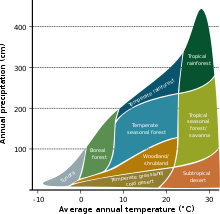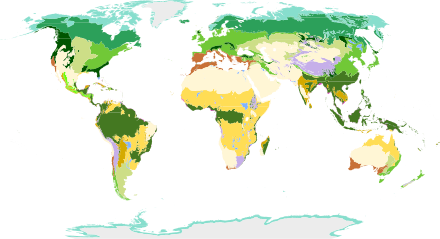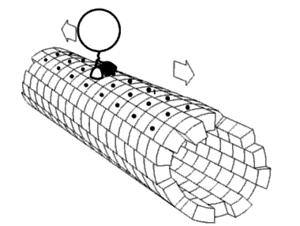The adiabatic theorem is a concept in quantum mechanics. Its original form, due to Max Born and Vladimir Fock (1928), was stated as follows:
- A physical system remains in its instantaneous eigenstate if a given perturbation is acting on it slowly enough and if there is a gap between the eigenvalue and the rest of the Hamiltonian's spectrum.
In simpler terms, a quantum mechanical system subjected to gradually changing external conditions adapts its functional form, but when subjected to rapidly varying conditions there is insufficient time for the functional form to adapt, so the spatial probability density remains unchanged.
Diabatic vs. adiabatic processes
| Diabatic | Adiabatic |
|---|---|
| Rapidly changing conditions prevent the system from adapting its configuration during the process, hence the spatial probability density remains unchanged. Typically there is no eigenstate of the final Hamiltonian with the same functional form as the initial state. The system ends in a linear combination of states that sum to reproduce the initial probability density. | Gradually changing conditions allow the system to adapt its configuration, hence the probability density is modified by the process. If the system starts in an eigenstate of the initial Hamiltonian, it will end in the corresponding eigenstate of the final Hamiltonian. |
At some initial time a quantum-mechanical system has an energy given by the Hamiltonian ; the system is in an eigenstate of labelled . Changing conditions modify the Hamiltonian in a continuous manner, resulting in a final Hamiltonian at some later time . The system will evolve according to the time-dependent Schrödinger equation, to reach a final state . The adiabatic theorem states that the modification to the system depends critically on the time during which the modification takes place.
For a truly adiabatic process we require ; in this case the final state will be an eigenstate of the final Hamiltonian , with a modified configuration:
The degree to which a given change approximates an adiabatic process depends on both the energy separation between and adjacent states, and the ratio of the interval to the characteristic time-scale of the evolution of for a time-independent Hamiltonian, , where is the energy of .
Conversely, in the limit we have infinitely rapid, or diabatic passage; the configuration of the state remains unchanged:
The so-called "gap condition" included in Born and Fock's original definition given above refers to a requirement that the spectrum of is discrete and nondegenerate, such that there is no ambiguity in the ordering of the states (one can easily establish which eigenstate of corresponds to ). In 1999 J. E. Avron and A. Elgart reformulated the adiabatic theorem to adapt it to situations without a gap.
Comparison with the adiabatic concept in thermodynamics
The term "adiabatic" is traditionally used in thermodynamics to describe processes without the exchange of heat between system and environment (see adiabatic process), more precisely these processes are usually faster than the timescale of heat exchange. (For example, a pressure wave is adiabatic with respect to a heat wave, which is not adiabatic.) Adiabatic in the context of thermodynamics is often used as a synonym for fast process.
The classical and quantum mechanics definition is closer instead to the thermodynamical concept of a quasistatic process, which are processes that are almost always at equilibrium (i.e. that are slower than the internal energy exchange interactions time scales, namely a "normal" atmospheric heat wave is quasi-static and a pressure wave is not). Adiabatic in the context of Mechanics is often used as a synonym for slow process.
In the quantum world adiabatic means for example that the time scale of electrons and photon interactions is much faster or almost instantaneous with respect to the average time scale of electrons and photon propagation. Therefore, we can model the interactions as a piece of continuous propagation of electrons and photons (i.e. states at equilibrium) plus a quantum jump between states (i.e. instantaneous).
The adiabatic theorem in this heuristic context tells essentially that quantum jumps are preferably avoided and the system tries to conserve the state and the quantum numbers.
The quantum mechanical concept of adiabatic is related to adiabatic invariant, it is often used in the old quantum theory and has no direct relation with heat exchange.
Example systems
Simple pendulum
As an example, consider a pendulum oscillating in a vertical plane. If the support is moved, the mode of oscillation of the pendulum will change. If the support is moved sufficiently slowly, the motion of the pendulum relative to the support will remain unchanged. A gradual change in external conditions allows the system to adapt, such that it retains its initial character. The detailed classical example is available in the Adiabatic invariant page and here.
Quantum harmonic oscillator
The classical nature of a pendulum precludes a full description of the effects of the adiabatic theorem. As a further example consider a quantum harmonic oscillator as the spring constant is increased. Classically this is equivalent to increasing the stiffness of a spring; quantum-mechanically the effect is a narrowing of the potential energy curve in the system Hamiltonian.
If is increased adiabatically then the system at time will be in an instantaneous eigenstate of the current Hamiltonian , corresponding to the initial eigenstate of . For the special case of a system like the quantum harmonic oscillator described by a single quantum number, this means the quantum number will remain unchanged. Figure 1 shows how a harmonic oscillator, initially in its ground state, , remains in the ground state as the potential energy curve is compressed; the functional form of the state adapting to the slowly varying conditions.
For a rapidly increased spring constant, the system undergoes a diabatic process in which the system has no time to adapt its functional form to the changing conditions. While the final state must look identical to the initial state for a process occurring over a vanishing time period, there is no eigenstate of the new Hamiltonian, , that resembles the initial state. The final state is composed of a linear superposition of many different eigenstates of which sum to reproduce the form of the initial state.
Avoided curve crossing
For a more widely applicable example, consider a 2-level atom subjected to an external magnetic field. The states, labelled and using bra–ket notation, can be thought of as atomic angular-momentum states, each with a particular geometry. For reasons that will become clear these states will henceforth be referred to as the diabatic states. The system wavefunction can be represented as a linear combination of the diabatic states:
With the field absent, the energetic separation of the diabatic states is equal to ; the energy of state increases with increasing magnetic field (a low-field-seeking state), while the energy of state decreases with increasing magnetic field (a high-field-seeking state). Assuming the magnetic-field dependence is linear, the Hamiltonian matrix for the system with the field applied can be written
where is the magnetic moment of the atom, assumed to be the same for the two diabatic states, and is some time-independent coupling between the two states. The diagonal elements are the energies of the diabatic states ( and ), however, as is not a diagonal matrix, it is clear that these states are not eigenstates of the new Hamiltonian that includes the magnetic field contribution.
The eigenvectors of the matrix are the eigenstates of the system, which we will label and , with corresponding eigenvalues
It is important to realise that the eigenvalues and are the only allowed outputs for any individual measurement of the system energy, whereas the diabatic energies and correspond to the expectation values for the energy of the system in the diabatic states and .
Figure 2 shows the dependence of the diabatic and adiabatic energies on the value of the magnetic field; note that for non-zero coupling the eigenvalues of the Hamiltonian cannot be degenerate, and thus we have an avoided crossing. If an atom is initially in state in zero magnetic field (on the red curve, at the extreme left), an adiabatic increase in magnetic field will ensure the system remains in an eigenstate of the Hamiltonian throughout the process (follows the red curve). A diabatic increase in magnetic field will ensure the system follows the diabatic path (the dotted blue line), such that the system undergoes a transition to state . For finite magnetic field slew rates there will be a finite probability of finding the system in either of the two eigenstates. See below for approaches to calculating these probabilities.
These results are extremely important in atomic and molecular physics for control of the energy-state distribution in a population of atoms or molecules.
Mathematical statement
Under a slowly changing Hamiltonian with instantaneous eigenstates and corresponding energies , a quantum system evolves from the initial state
with the dynamical phase
and geometric phase
In particular, , so if the system begins in an eigenstate of , it remains in an eigenstate of during the evolution with a change of phase only.
Example applications
Often a solid crystal is modeled as a set of independent valence electrons moving in a mean perfectly periodic potential generated by a rigid lattice of ions. With the Adiabatic theorem we can also include instead the motion of the valence electrons across the crystal and the thermal motion of the ions as in the Born–Oppenheimer approximation.
This does explain many phenomena in the scope of:
- thermodynamics: Temperature dependence of specific heat, thermal expansion, melting
- transport phenomena: the temperature dependence of electric resistivity of conductors, the temperature dependence of electric conductivity in insulators, Some properties of low temperature superconductivity
- optics: optic absorption in the infrared for ionic crystals, Brillouin scattering, Raman scattering
Deriving conditions for diabatic vs adiabatic passage
We will now pursue a more rigorous analysis. Making use of bra–ket notation, the state vector of the system at time can be written
where the spatial wavefunction alluded to earlier is the projection of the state vector onto the eigenstates of the position operator
It is instructive to examine the limiting cases, in which is very large (adiabatic, or gradual change) and very small (diabatic, or sudden change).
Consider a system Hamiltonian undergoing continuous change from an initial value , at time , to a final value , at time , where . The evolution of the system can be described in the Schrödinger picture by the time-evolution operator, defined by the integral equation
which is equivalent to the Schrödinger equation.
along with the initial condition . Given knowledge of the system wave function at , the evolution of the system up to a later time can be obtained using
The problem of determining the adiabaticity of a given process is equivalent to establishing the dependence of on .
To determine the validity of the adiabatic approximation for a given process, one can calculate the probability of finding the system in a state other than that in which it started. Using bra–ket notation and using the definition , we have:
We can expand
In the perturbative limit we can take just the first two terms and substitute them into our equation for , recognizing that
is the system Hamiltonian, averaged over the interval , we have:
After expanding the products and making the appropriate cancellations, we are left with:
giving
where is the root mean square deviation of the system Hamiltonian averaged over the interval of interest.
The sudden approximation is valid when (the probability of finding the system in a state other than that in which is started approaches zero), thus the validity condition is given by
which is a statement of the time-energy form of the Heisenberg uncertainty principle.
Diabatic passage
In the limit we have infinitely rapid, or diabatic passage:
The functional form of the system remains unchanged:
This is sometimes referred to as the sudden approximation. The validity of the approximation for a given process can be characterized by the probability that the state of the system remains unchanged:
Adiabatic passage
In the limit we have infinitely slow, or adiabatic passage. The system evolves, adapting its form to the changing conditions,
If the system is initially in an eigenstate of , after a period it will have passed into the corresponding eigenstate of .
This is referred to as the adiabatic approximation. The validity of the approximation for a given process can be determined from the probability that the final state of the system is different from the initial state:
Calculating adiabatic passage probabilities
The Landau–Zener formula
In 1932 an analytic solution to the problem of calculating adiabatic transition probabilities was published separately by Lev Landau and Clarence Zener, for the special case of a linearly changing perturbation in which the time-varying component does not couple the relevant states (hence the coupling in the diabatic Hamiltonian matrix is independent of time).
The key figure of merit in this approach is the Landau–Zener velocity:
Using the Landau–Zener formula the probability, , of a diabatic transition is given by
The numerical approach
For a transition involving a nonlinear change in perturbation variable or time-dependent coupling between the diabatic states, the equations of motion for the system dynamics cannot be solved analytically. The diabatic transition probability can still be obtained using one of the wide variety of numerical solution algorithms for ordinary differential equations.
The equations to be solved can be obtained from the time-dependent Schrödinger equation:
where is a vector containing the adiabatic state amplitudes, is the time-dependent adiabatic Hamiltonian, and the overdot represents a time derivative.
Comparison of the initial conditions used with the values of the state amplitudes following the transition can yield the diabatic transition probability. In particular, for a two-state system:










































![{\displaystyle {\begin{aligned}\varepsilon _{1}(t)&=-{\frac {1}{2}}{\sqrt {4a^{2}+(\hbar \omega _{0}-2\mu B(t))^{2}}}\\[4pt]\varepsilon _{2}(t)&=+{\frac {1}{2}}{\sqrt {4a^{2}+(\hbar \omega _{0}-2\mu B(t))^{2}}}.\end{aligned}}}](https://wikimedia.org/api/rest_v1/media/math/render/svg/d4dc8f85991c0276ffeacc4151eafc23bd38608f)
































































